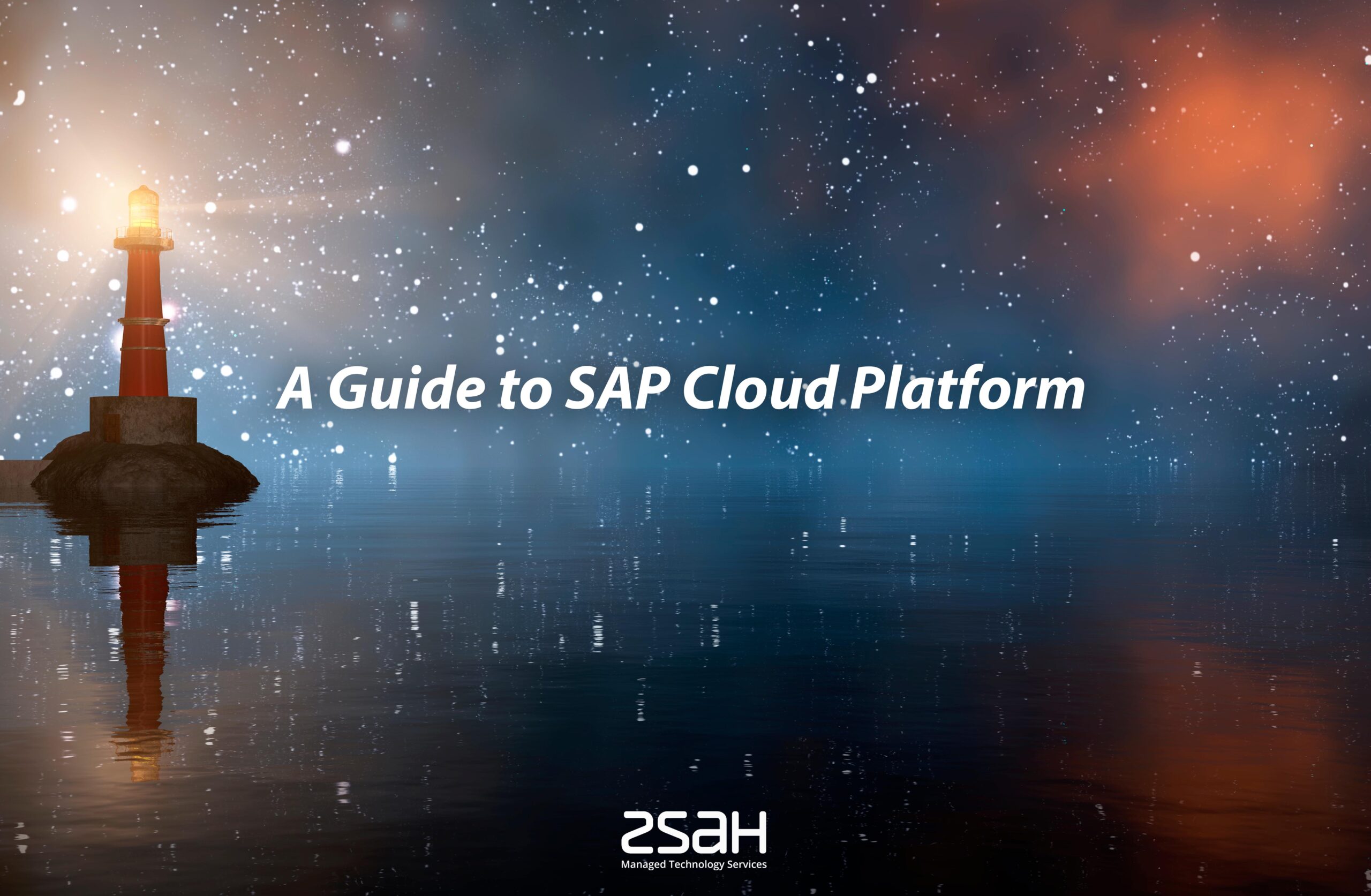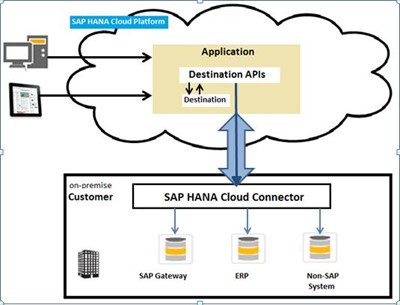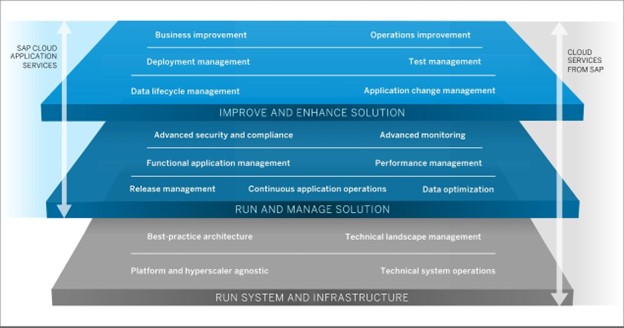A Guide to SAP Cloud Platform

SAP Cloud Platform (SCP) is a Platform as a Service (PaaS) offering which serves as a development and runtime environment for cloud applications. Designed for enterprise usage, the primary intention of SAP Cloud Platform is to enable organisations to extend their existing on-premises or cloud-based Enterprise Resource Planning (ERP) applications with next-generation technologies such as advanced analytics, artificial intelligence (AI), machine learning, or blockchain.
The SAP Cloud Platform also empowers organisations to build and deploy new enterprise cloud and mobile apps, integrate and connect enterprise applications regardless of their location or source data, and connect enterprise applications and data with Internet of Things (IoT) environments.
SAP Cloud Platform History
The System Analysis Program Development company (later abbreviated to SAP) was founded in Germany in 1972, under its local name System Analyse Programmentwicklung. The company’s corporate legal designation is SAP SE, where SE stands for Societas Europaea, a public company registered in accordance with European Union corporate law. The name is officially pronounced as the separate letters, S-A-P.
With its introduction of SAP R/2 and SAP R/3, SAP established the global standard for ERP software. In the company’s own words, “SAP was one of the first companies to develop standard software for business solutions and continues to offer industry-leading ERP solutions.” These solutions centralise data management and provide multiple business functions with a single view of the truth.
SAP Cloud Platform Architecture
The SAP Cloud Platform is based on SAP HANA in-memory database technology and uses open source and open standards. In this way, SAP Cloud Platform enables independent software vendors (ISVs), startups, and developers to create and test HANA-based cloud applications.
The SAP HANA Cloud connector connects between on-demand applications in SAP HANA Cloud Platform and existing on-premise systems. The Cloud connector runs as on-premise agent in a secured network, and acts as a reverse invoke proxy between the on-premise network and SAP HANA Cloud Platform.
[Image source: SAP]
SAP’s open standards give developers flexibility and control over which clouds, frameworks, and applications they can deploy. To facilitate this flexibility, SAP Cloud Platform uses different development environments, including Cloud Foundry and Neo, and provides a variety of programming languages.
SAP Cloud Platform Components and Resources
[Video source: YouTube]
SAP Cloud Platform offers both integration Platform as a Service (iPaaS) and Platform as a Service (PaaS) cloud tools. The platform incorporates innovative technologies that include big data, IoT, AI, and machine learning (ML). While the SAP Cloud Platform supports native services and products by SAP, it also provides support for products and services from popular platforms such as Microsoft Azure, Google Cloud Platform, Amazon AWS, and Alibaba Cloud.
This combination of offerings and integrations enables a globally dispersed customer base from a range of company sizes to use SAP Cloud Platform for building application extensions, integrating landscapes, or extending existing enterprise applications in the cloud. SAP Cloud Platform currently has more than 230 million cloud users, more than 100 solutions covering all business functions, and boasts the largest cloud portfolio of any provider.
The SAP Cloud Platform offers a wide variety of tools, application capabilities, services, and Application Programming Interfaces (APIs). In total, the company lists over 19 capabilities which fall under data-based services and analytics, emerging technologies, user-based activities, and application development and deployment. They include the following.
Analytics
SAP Cloud Platform Analytics functions enable users to embed advanced analytics into applications for real-time insight. Tools on offer include SAP Data Intelligence, SAP Web Analytics, SAP Analytics Cloud, SAP Leonardo Internet of Things, SAP Edge Services, IoT, SAP HANA Cloud, SAP ASE Service, and SAP Streaming Analytics.
DevOps
DevOps, an amalgam of Development and Operations, is a concept and methodology which simplifies application development and operations. SAP Cloud Platform offers a Platform as a Service or PaaS tool for developing and running cloud-based applications. In addition, SAP HANA Enterprise Cloud (HEC) is an Infrastructure as a Service (IaaS) tool which enables companies to run SAP-based operations in a hosted environment.
Digital Experience
Tools and services that SAP Cloud Platform offers in this category include Document Service, Portal, SAP Conversational AI, Mobile Services, SAP Build, SAPUI5, and SAP Fiori Cloud.
Enterprise Extensions
In this category, SAP Cloud Platform offers a number of tools and services, which include SAP Business Application Studio, SAP Localization Hub, Tax Service, Data Enrichment for SAP S/4HANA, SAP Data Quality Management, ABAP environment, and SAP Web IDE.
Integration Suite
The ability to integrate on-premises and cloud applications is central to the philosophy of SAP. The company’s integrated applications connect all parts of a business into an intelligent suite on a fully digital platform.
The SAP Cloud Platform Integration suite continues in this tradition with a selection of tools and services that include API Management, Cloud Integration, Open Connectors, OData Provisioning, and Smart Data Integration.
Intelligent BPM
With a systematic approach and the strategic automation of workflows, Business Process Management (BPM) enables organisations to streamline their operations, and achieve greater efficiency and productivity.
SAP Cloud Platform Intelligent BPM offers a set of tools and functionality that includes Business Rules, Process Visibility, SAP Intelligent Robotic Process Automation (RPA), and Workflow.
Mobile
SAP Cloud Platform offerings in this category focus on mobile app development and integration.
The standout among them is SAP Cloud Platform SDK for iOS, a Software Development Kit which enables developers to build mobile apps for iPhones and iPads with data integration from back-end enterprise applications to the iOS front end. The Software Development Kit (SDK) uses the Apple Swift open programming language. In addition, the SDK comes with a library of prebuilt UX components, and access to iOS device capabilities such as Touch ID, location services, and notifications.
Platform Foundation
This category of capabilities on the SAP Cloud Platform includes several services and functions that typically run behind the scenes to facilitate SAP Cloud Platform operations. Among them are Alert Notification, Application Logging, Data Retention Manager, Job Scheduler, Java Server, and Transport Management.
Pricing Considerations for SAP Cloud Platform Users
The SAP Cloud Platform’s commercial licensing models take two forms: subscription-based, and consumption-based.
Organisations opting for the subscription-based model get access to SAP Cloud Platform services for a fixed price and defined time, during which they can use as many or as much of the services as they want. This approach provides customers with predictable costs, so long as they remain subscribed to the service.
Under the consumption-based model, customers spend credits to buy SAP Cloud Platform services, which they are at liberty to use as they like. Organisations must pay for these credits up front and can keep a tally of their expenses via a cloud credit balance, which is kept for all the services they use. In this way, SAP Cloud Platform customers can start small and scale their development projects in line with changing business and market conditions.
How SAP Cloud Platform Has Evolved to Benefit Business Users
Since its founding in 1972, SAP has grown from a small, five-person endeavour to a multinational enterprise employing more than 105,000 workers worldwide. With its centralised data management and single source of truth, SAP software helps organisations better manage complex business processes by giving employees from different departments easy access to real-time insights across the enterprise. In this way, businesses can streamline workflows, improve operational efficiency, increase productivity, and enhance customer experiences.
SAP Cloud Platform was previously known as SAP HANA Cloud Platform. While still a relatively young offering in the cloud market, SAP Cloud Platform uses open standards to offer enterprises greater flexibility and scalability in extending, integrating, and developing applications on premises and in the cloud.
Offerings from SAP Cloud Application Services help organisations manage applications across SAP cloud solutions, including hyperscale, hybrid, and multi-cloud deployment scenarios. To this end, SAP Cloud Application Services provides fixed-price, outcome-based packages that offer a comprehensive range of services for managing business process and application logic, data layers, application security, software releases, performance, integrations, and more.
[Image source: SAP]
The SAP Cloud Platform facilitates the seamless integration of existing business solutions and hybrid system landscapes. By offering various development tools and capabilities, it also simplifies the development of native business applications.
Through its open programming standards and Software Development Kits, SAP Cloud Platform empowers commercial developers and enterprises to deliver tailored end-to-end interfaces for improved user experience. With the option to build apps in the Kubernetes environment, SAP Cloud Platform also simplifies application interface management.
SAP has recently announced that it will be retiring the SAP Cloud Platform brand name and moving the capabilities of the cloud service into the SAP Business Technology Platform (SAP BTP). This move is intended to assist with cloud data management and analytics, along with other components of the platform. However, existing customers of SAP Cloud Platform will continue to benefit from its products under the banners of the SAP Integration Suite and SAP Extension Suite.
A few of the competitors for SAP Cloud Platform include:
Each cloud provider has its strengths and specialities that can make it suitable for different businesses or purposes.
Sign Up Now!
For expert advice and resources – blogs, interviews, webinars, guides and more.



